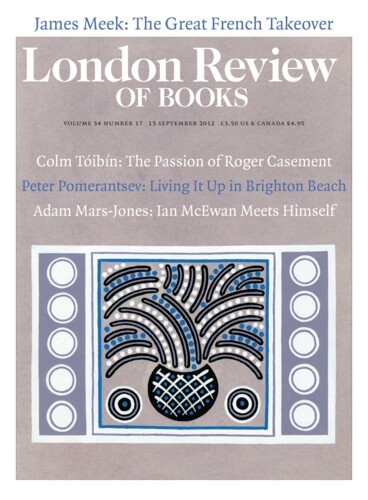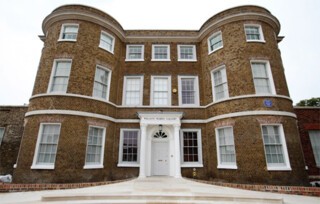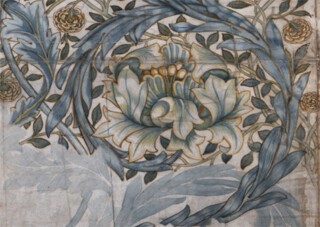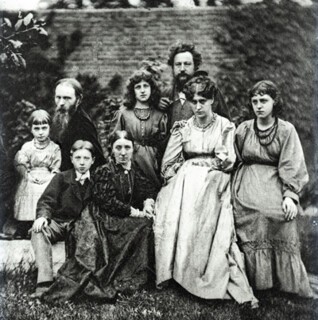The William Morris Gallery in Walthamstow was reopened on 2 August by Chris Robbins, leader of Waltham Forest Council, who pronounced its refurbishment ‘truly stunning’. He said how ‘extremely proud’ he and his fellow councillors were to have been part of the ‘multimillion-pound development’, which has seen the fine Georgian house that was Morris’s childhood home from 1848 to 1856 ‘restored to its former glory’ and its collections enhanced by a new space for temporary exhibitions, a tea room and a freshly landscaped park. The first four days of opening brought six thousand visitors and favourable reviews.
The last time I was at the gallery, early in 2007, the council was telling a different story. I was among a restive and increasingly incredulous group of local residents and others, crammed into what is now the shop, to hear Naz Sarkar, council cabinet member for leisure, arts and culture, defend plans to close the gallery during the week, dispense with the curatorial staff and send the collection of historic tapestries, drawings and glass on a tour of local schools. That year the council’s then leader described Morris as ‘a white imperialist’ of no relevance to Walthamstow. The spectacular row which ensued generated online petitions, national press coverage and representations from the William Morris Society in the United States. Morris’s birthday, 24 March, saw demonstrations at the gallery and the Victorian Society, dressed in forensic suits, taped off Walthamstow Town Hall and declared it a Heritage Crime Scene. As the dispute went on two things became clear: significant numbers of local people did not think that the best way to help one of London’s most deprived boroughs was to deprive it of its only world-class cultural asset, and far from being irrelevant Morris remained politically divisive.
One Walthamstow protester voiced the widely held opinion that the ‘New Labour councillors’ were embarrassed by the gallery, opened in 1950 by Attlee, because it reminded them of a political tradition they had ‘long ago abandoned and betrayed’. This was perhaps to credit them with a stronger grasp of history than they possessed, but it was noticeable that expressions of concern from sitting Labour MPs and party members with parliamentary ambitions were lukewarm, while the list of Labour opponents to the plans was a roll-call of the old guard, headed by Tony Benn and Ken Livingstone. The curatorial staff, feeling that their union, Unison, was similarly reluctant to get into a dispute with the Labour council, accepted redundancy. With the keeper Peter Cormack went thirty years’ knowledge of the collections as well as his reputation as a scholar of Morris and the Arts and Crafts. There was no one left to point out, as Cormack tried to do, that, far from being an imperialist, Morris lost much of his popular support in 1885 when he defended the Sudanese after the fall of Khartoum, arguing that General Gordon had no business being there in the first place. Such subtleties were lost along with much else in the hue and cry. A lottery bid which Cormack had been working on was abandoned and the drastically diminished gallery limped on.
Exactly why things changed is unclear. The strength of local opposition, ‘the sound and rumour’, as Morris described it in his Chants for Socialists, of ‘the people marching on’, must have unnerved the council as blogs and protest meetings moved beyond the issue of the gallery to exchange views about other council services, councillors’ remuneration, ‘patronising’ attitudes and general discontent. Sarkar was taken off the arts and culture brief and later failed to be selected as Labour’s parliamentary candidate for Walthamstow. Cormack’s lottery bid was dusted off, completed and submitted in 2009. Other grants and funding followed, making the restoration possible. The gallery’s running costs are now guaranteed by the council indefinitely and new staff, with the right expertise in art history and curatorship, have been taken on. Entry remains free. The result is a great success. There has been no attempt to simplify the complex life and mind of Morris, whose titanic idealism reflected an age of great certainty and equally harrowing doubt. His radicalism, sometimes denigrated as the hypocrisy of a man who grew rich by selling luxury goods, is shown to have developed directly out of his experience of capitalist business. Realising that in the existing state of society a well-paid and contented labour force producing high quality goods would be unable to sell them to anyone but the ‘swinish’ rich, he concluded that society should be reorganised and became a Marxist. Among the objects newly conserved and on show is a socialist banner designed by Burne-Jones.
It is for his patterns, tiles and furniture that Morris is best remembered now, and these are well displayed, with the familiar chairs and wallpapers shown at one point beside the furnishings of an ordinary Victorian drawing-room to make them look as startling and fresh as they were to their first owners. The modernist myth that the Red House, which he commissioned from Philip Webb, was the springboard of architectural functionalism is quietly and rightly ignored, while aspects of Morris’s endeavours that are less often considered – his passion for Iceland and its poetry – are given their due. In the sagas Morris believed he had found the poetic equivalent of the folk traditions he was reviving in craftwork and he not only translated them but travelled to Iceland to visit the sites and experience the landscape they describe. There is space at the gallery too for a changing display devoted to Morris’s legacy in the Arts and Crafts movement. By the time his example had inspired them, the guilds that were formed to follow his lead in the revival of handwork irritated him. He had moved on to political activism. But with typical largeness of character he came round to his admirers in the end.
Morris never belonged to the Labour Party. As one contributor to the comment board writes, ‘if he was alive now he’d probably be in Greenpeace,’ so the resurrected gallery is not exactly a victory for old or new Labour. It is instead a triumph for Morris himself. Skateboarders now enjoy the drive where, as a child, he rode out in the miniature suit of armour that was one of his favourite toys, and, surprised as he might be to see them, Morris would recognise in this new incarnation of his old home one of his own most consistent principles, the intelligent enjoyment of the pleasures of everyday life.
Send Letters To:
The Editor
London Review of Books,
28 Little Russell Street
London, WC1A 2HN
letters@lrb.co.uk
Please include name, address, and a telephone number.




